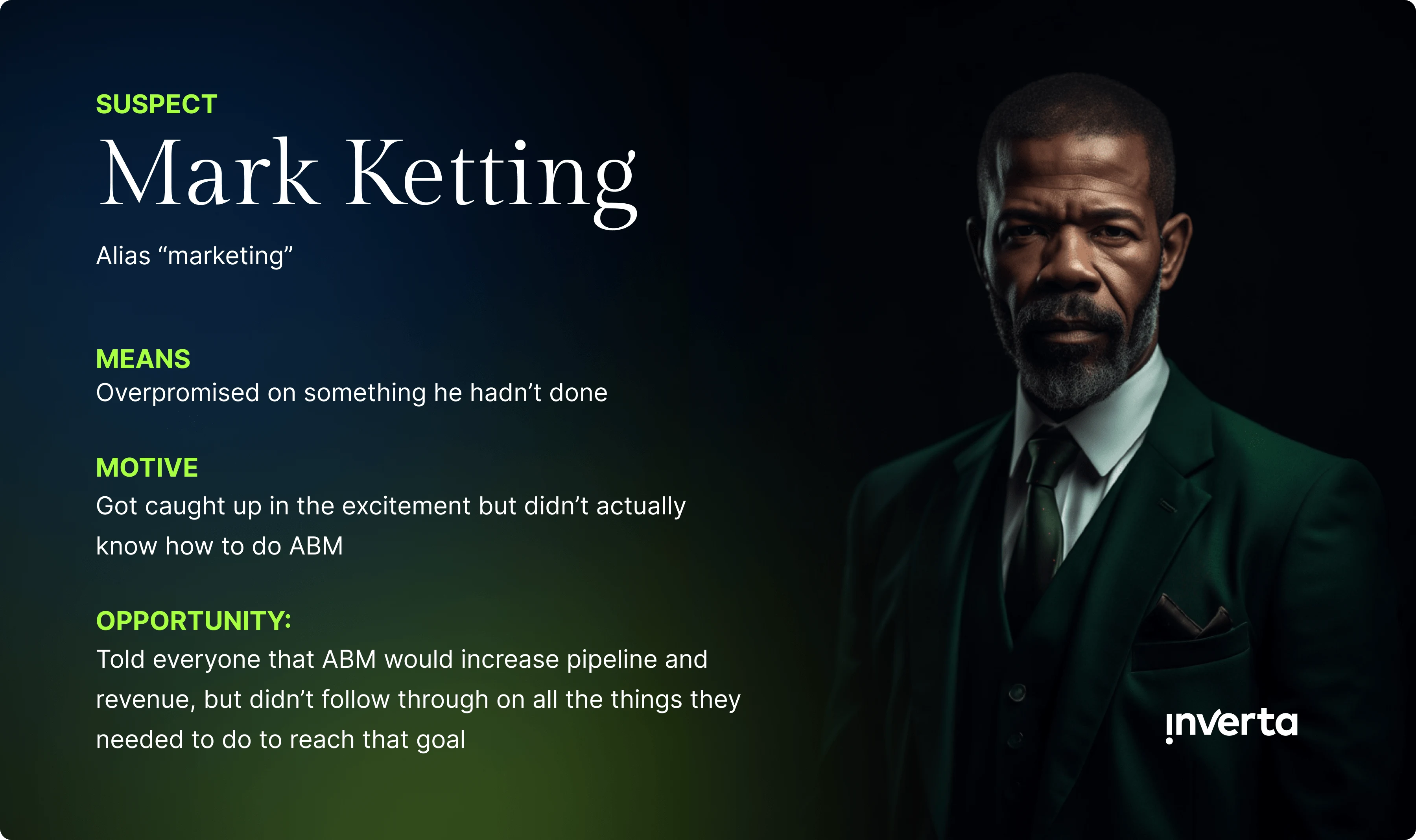Marketing Most Foul

In the last issue of Who Killed ABM, we tracked Ted Nology (alias “Technology”) back to the old server room and asked about all the expensive SaaS marketing apps we’d seen everyone else using. Ted grew animated—then furious—that the good times with ABM had come to an end when she disappeared.
Ted didn’t love all those cloud apps either—in fact, he disliked them. It was too much to manage. He was just as hungry as everyone else for consolidation, and with ABM, he got that.
Was he the killer? Perhaps. But his means are less obvious than some others. Gosh. We’ve interviewed so many now. And heard so many plausible alibis.
I suppose that means the only suspect left is, well… us.
It pains us to do this. Our close personal friend and collaborator, Mark Ketting (alias “Marketing”), is absolutely the last person we wanted to point the finger at. Did we … did we do it to ourselves?
The next clue: A deck of 100 beautiful but empty slides
By the end of the 2010s, the marketing jokes grew self-reflective. (See: anything by The Marketoonist.) Then the jokes grew morose as marketers bitterly posted warnings on LinkedIn to “Never work for a CEO who doesn’t understand marketing.”
Then, the firings began.
In 2023, around 200,000 tech workers were laid off. While we don’t have granular data to know for sure how many were marketers, anecdotally, it was significant. Marketing is often first cut in a downturn, both because it feels expendable (the effects aren’t felt immediately) and most CEOs, who overwhelmingly do not hail from marketing backgrounds, don’t understand it.
Yet companies had no sooner gutted the marketing function than they started embarking upon large marketing projects, like rebrands, with no marketer at the helm. Everyone seemed to be fundamentally rethinking the practice itself — a kind of ABM marketing scandal that mirrored the confusion and contradictions within the industry.
“If we’re being really honest with ourselves, when it came to ABM, marketing undersold, underdelivered, and didn’t truly understand what was involved,” says Kathy Macchi, Inverta co-founder. “We brought ABM to the pitch and believed all the vendor problems we knew about weren’t so bad and easily solved.”
But they weren’t so easily solved. Psychologists call it the “rhyme over reason” fallacy, but what sounded great in pitch decks didn’t survive the brutal reality of market forces. And what made complete sense in conversations often warped and changed once deployed.
Perhaps some marketers also purchased software to avoid having difficult internal conversations. How many Marketo, ZoomInfo, or Drift purchases were made to circumvent sales, IT, or the web team?
And then suddenly marketing was facing a reckoning: Should it even exist?
The only true way for executives to know was by principle of displacement: Cut everyone and watch the profit and loss statement. No doubt a great many executives also purred about ChatGPT as a suitable replacement—so low was their opinion, apparently. Several notable companies from UPS to Datadog to Etsy axed the CMO role. (There’s a “department of arts and crafts” joke in there somewhere but perhaps it’s too soon.) These top marketers were replaced by chief revenue officers or chief commercial offices or titles that more clearly stated their fealty to revenue, with a capital, measurable “R.”
Were those companies right to try cutting marketing? Did marketers do this to themselves by overpromising and failing to account-based wins out of such an expensive tech stack?
The uncomfortable truth is much of marketing is unmeasurable. From the concept of dark social to the idea of brand affinity, marketing is both nowhere and everywhere. Necessary, vital, yet dismissable and sometimes unmissed if cut—at least at first.
Here’s what those marketers who complained about never working for a CEO who doesn’t understand marketing were getting at, and they had a point. Good marketing delivers vast, unmeasurable but palpable value. Behind any brand you admire or have a “crush on” is a team of marketers who whittled that identity and message into an ad or conference-booth-shaped wedge and pierced your heart. There are people thinking about you and your needs along with how the company can help you be better at your job and get promoted. They give the swag and insights away for free because it’s their job to help you — a rare example of foul play in marketing that turns out to be virtuous after all.
Yet marketing could have had the most admirable of intentions and still oversold. And to understand if that sad reality came to pass, and Mark Ketting to have turned so suddenly and viciously on ABM, we tracked him down to the fourth floor of the Conan Doyle Industries office in San Mateo.
And stepped inside.
Mark Ketting’s alibi
“So it’s come to this, huh?” Mark slowly spins in his ergonomic chair as we enter.
“Mark, I hate to do this to you, but an investigation’s an investigation,” we say, pulling out a chair in front of his desk to sit down.
“So all those years we worked together and you still think I could be capable of murder? Your own partner? I don’t believe it,” he shakes his head.
“Mark, let’s leave our personal history out of this. I just want to know the truth.”
“You want to know the truth? Try looking in the goddamn mirror! You dress up and play detective but you’re just as implicated in all this as we are. Before you joined the force, you worked here at Conan Doyle Industries too, as a consultant. Is that a convenient fact you forgot to tell your audience?”
“Mark, I—”
“Save it. I don’t want to hear your sob stories. Unless you know anything about what really happened to ABM, I don’t want any part of this.”
“The truth is, Mark, I’m at my wit’s end,” I sigh, pulling out a legal pad to go over our notes. “Everyone’s got an alibi. Vega List fixed her target account list in the end. Brian Journey actually properly mapped his buyer’s journey. Strata Ji pivoted from the demand waterfall. Sal Parson changed her sales strategy. Trent Zishion became a champion of change after resisting it for so long. Ted Nology consolidated his tech stack for ABM. We’re the only ones left.”
“Well I’ll be damned,” Mark says. “Would have been much easier if Sales had just done it.”
We hide our chuckle with a cough. “Yeah, that’s for sure.”
“Well, where does that leave us, then?” Mark asks. “Because there’s gotta be an explanation. You know I loved ABM like my own daughter, but could it have been us? Did we kill her in our sleep or something? I saw that in a movie once…”
“I think it’s pretty unlikely, but let’s go over the timeline. At least I can make sure the report I bring back to my superiors is thorough.”
“Alright, where should I start?” Marks says.
“At the beginning—how was it when ABM first joined?”
“At first, it was a box to tick,” he says, carefully. “Something to put on the slide for our annual plan. I didn’t want to look like I was behind the times when everyone else was so excited about it. But I was hesitant—and for good reason. It didn’t really work at first. I’m sure you heard how our first attempt with sales failed?”
We nod. “What happened next?”
“Well, despite my attempts to convince her to give it up, ABM persisted,” Mark continues. “And you know, I’ve never been so wrong in my entire life. Once that 1:many program got off the ground, there was just this energy. You were there, you know what I was talking about. Marketing was winning business and we were gaining respect. Everyone looked up to us. That was a nice feeling, to be respected and not be the butt of some joke about basket-weaving.”
“So what happened?” we ask.
“Well, first it was the pandemic. Everyone got more budget-conscious. And even though what we were doing was working, we had to defend our choices to cost-cutting executives. They wanted to see hard data. Thanks to ABM, we’d gotten a lot more organized, but the truth was that our data was overly skewed towards advertising and digital channels because that’s what we could easily track, even though it’s just a small fraction of what we do. That wasn’t enough for them. They wanted more. Clicks, MQLs, it all came back to the forefront. It was hard to truly show our impact on revenue.” His eyes darken. “That was the beginning of the end.”
“What happened next?” we ask.
“The layoffs started. We felt lucky to have jobs at all. We all had to ‘do more with less.’ It just felt easier to do what our execs wanted than push for best-in-class. I should have stood up for ABM better, but I didn’t have the energy—I was burnt out and just trying to get through the day.”
We nod sympathetically.
He runs his fingers through his beard. “Honestly, I let ABM down. A new CMO came in and wanted to change everything and we just didn’t have the strength to fight it. I noticed ABM getting quieter and quieter in meetings. She’d stay camera-off on Zoom and when we finally returned to office, she seemed a shell of herself—none of that initial spark. Then one day, she didn’t show up at all and here we are.” He shakes his head. “I have no more idea than you what really happened.”
“So you don’t know who killed ABM?”
“No,” he shakes his head sadly. “Coulda been anyone.”
“Mark, you’re brilliant! I’ve gotta go, I know who did it—”
So, did Mark Ketting kill ABM?
Our lips are sealed. Join us next week for the series’ thrilling conclusion where we (finally) reveal the truth.



